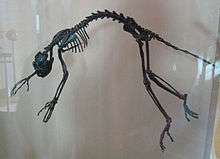Adapiformes
| Adapiformes | |
|---|---|
 | |
| Notharctus tenebrosus | |
| Scientific classification | |
| Kingdom: | Animalia |
| Phylum: | Chordata |
| Class: | Mammalia |
| Order: | Primates |
| Suborder: | Strepsirrhini |
| Infraorder: | †Adapiformes Hoffstetter, 1977 |
| Families | |
| |
Adapiformes is an extinct group of early primates. Adapiforms radiated throughout much of the northern continental mass (now Europe, Asia and North America), reaching as far south as northern Africa and tropical Asia. They existed from the Eocene to the Miocene epoch. Some adapiforms looked similar to living lemurs.
Adapiforms are known from the fossil record only, and it is unclear whether they form a monophyletic or paraphyletic group. When assumed to be a clade, they are usually grouped under the "wet-nosed" taxon Strepsirrhini, which would make them more closely related to the lemurs and less so to the "dry-nosed" Haplorhini taxon that includes monkeys and apes.[3]
In 2009, Franzen and colleagues placed the newly described genus Darwinius in the "Adapoidea group of early primates representative of early haplorhine diversification" so that, according to these authors, the adapiforms would not be within the Strepsirrhini lineage as hitherto assumed but qualify as a stem "missing link" between Strepsirrhini and Haplorrhini.[4] However, subsequent analysis on the Darwinius fossil by Erik Seiffert and colleagues rejects this "missing link" idea, classifying Darwinius and other adapiforms within the Strepsirrhini.[5]
Classification
Adapiforms belong to the infraorder Adapiformes, which contains a single superfamily, Adapoidea.[6] The group also is sometimes treated as a superfamily (Adapoidea) alongside the other living strepsirrhine superfamilies, Lemuroidea (lemurs) and Lorisoidea (lorises and galagos).[7]
- Infraorder Adapiformes
- Superfamily Adapoidea
- Family Notharctidae
- Family Sivaladapidae
- Family Adapidae
- Superfamily Adapoidea
- Infraorder incertae sedis
- Superfamily incertae sedis
- Family Azibiidae
- Family Djebelemuridae
- Superfamily incertae sedis
Rose (1995) suggests that early adapiformes and omoyiformes shared a common ancestor dating to the Thanetian epoch.[8]
References
- ↑ Dunn, Rachel H. (2016). "New euprimate postcrania from the early Eocene of Gujarat, India, and the strepsirrhine–haplorhine divergence". Journal of Human Evolution. 99: 25–51. doi:10.1016/j.jhevol.2016.06.006.
- ↑ Twenty-five little bones tell a puzzling story about early primate evolution
- ↑ Callum Ross, Richard F. Kay, Anthropoid origins: new visions, Springer, 2004, ISBN 978-0-306-48120-8, p. 100
- ↑ Franzen, Jens L.; et al. (2009). Hawks, John, ed. "Complete Primate Skeleton from the Middle Eocene of Messel in Germany: Morphology and Paleobiology". PLoS ONE. 4 (5): e5723. Bibcode:2009PLoSO...4.5723F. doi:10.1371/journal.pone.0005723. PMC 2683573. PMID 19492084.
- ↑ Ritter, M. (October 21, 2009). "Primate fossil called only a distant relative". Associated Press. Retrieved 2012-01-12.
- ↑ Fleagle 2013, p. 415.
- ↑ Rose 2009, p. 286.
- ↑ Ross, Callum; Kay, Richard F, eds. (2004). Anthropoid Origins: New Visions. Springer Science & Business Media. p. 713. ISBN 978-1461347002.
Sources
- Rose, K.D. (2009). The Beginning of the Age of Mammals. Johns Hopkins University Press. ISBN 978-0-801-89221-9. OCLC 646769601.
- Fleagle, J.G. (2013). Primate Adaptation and Evolution (3rd ed.). Academic Press. ISBN 978-0-123-78633-3. OCLC 820107187.